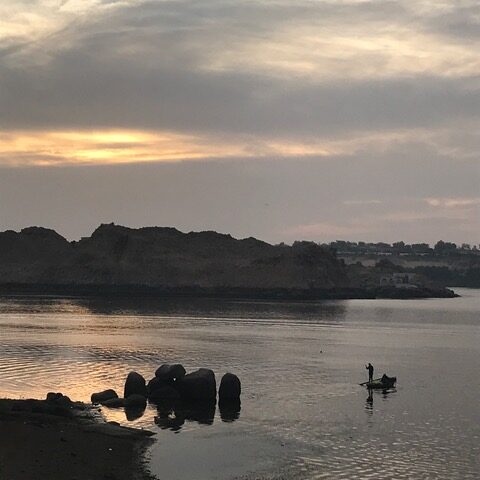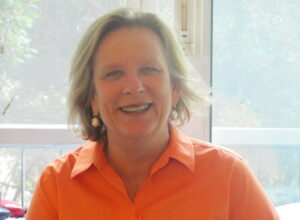When I teach Immigrant Literature, I begin with the poems carved on the walls of the Angel Island immigration station and the interviews with those who were held there. The book, Island: Poetry and History of Chinese Immigrants on Angel Island, 1910-1940, edited by Him Mark Lai, Genny Lim, and Judy Yung, gathers together these poems and stories, giving us a glimpse into the lives of those who came across the ocean, hoping to reach America, only to find themselves captured within the walls of this building located on an island in the San Francisco Bay. Some were detained for only a few weeks while others remained for almost two years. I’ve read the poems carved on the walls, perused the interviews, and watched the documentary film, Carved in Silence. But I know that none of that is the same as being physically in a space.
In 1969, when I was eight years old, my parents and I immigrated from Egypt to the United States. The tickets my parents held in their hands marked Los Angeles as our final stop where my mother’s cousin and her husband had already settled. But our short visit to Boston to see a distant aunt and uncle who had immigrated six months before us became permanent. For all these years, California has remained a ghost in my imagination. In the summer of 2017, I took my first trip to California, tracing my steps back to our original destination.
I walk through the barracks of Angel Island. In the dormitory rooms, three-tiered beds hang from the ceiling. The beds are narrow and short, just enough space to lie still on your back. Families were separated, putting men and women in different rooms. Attached to each sleeping area, there is a sitting room—a place for conversation, playing games to pass the time, maybe some simple gambling. I didn’t realize there was so little privacy in this space where people slept on top of each other.
When we arrived in Boston, we stayed with my aunt and uncle in their studio apartment for a few months. My mother and aunt slept on the sofa bed in the living room, I slept on a cot in the kitchen, and I can’t recall where my father and uncle slept. The studio was too small in my memory to make room for them. I fell asleep to my aunt’s loud laughter and my uncle’s teasing voice along with my parents’ excited and anxious tones filling the tiny apartment.
We stand at the shore of Angel Island and my daughter Celine points out the magnificence of the view, the water reaching out to curve around the land across the bay. Looking to the other side, you can detect buildings through the fog, an imagined life of abundance. A fence surrounds the barracks, a blockade through which you can see water and city; To be on this island with this majestic view but to feel only imprisoned, captured by the dream that immigrants strived for as they made their way here.
The Chinese Exclusion Act of 1882, which remained in effect until 1943, essentially banned Chinese immigration to the U.S. It was fueled by the fear of the Chinese taking jobs away from Americans and the prejudice against their culture. In 1906, the San Francisco earthquake destroyed most of the birth records, allowing the Chinese in the U.S. to claim they were American citizens and could therefore bring their family members from China. Many arrived with forged papers, claiming to be “paper sons” and “paper daughters” of the Chinese in America, so they could be granted entry into what they called the “Gold Mountain.”
Most people have heard of Ellis Island, but few know about Angel Island, which opened in 1910 to handle the large numbers coming into the country after the San Francisco earthquake. During their detention, the immigrants were held for questioning, asked about every detail of their lives to see if their answers matched what their “father” in America had said. Questions ranged from “How many windows were in your home?” to “Where were your brothers and sisters born?” When my husband was in the hospital, I was asked how many steps does it take to get into our house. We’d been living there for twelve years, and I answered confidently, “Three steps to the walkway and three to the front door.” When we returned home, I realized there are four steps to the front door.
Was it an act of desperation or greed that pushed people to make this journey across the ocean, to relinquish their familiar lives and their identities for the promise of a new world? On the boat to America, they memorized the coaching papers to prepare for the interrogation, to create a new identity. When one of them stumbled over a question, they could write a note and attach it to the bottom of a bowl where the kitchen staff would take it to the appropriate person in Chinatown and return with an answer for the detainee.
My father armed himself with the pages from the yellow phone book listing all the engineering firms in Boston, and went to each one. If he couldn’t get an interview, he left his resume, and made his way down the list until he was hired. My aunt took my mother to the company where she worked and helped her fill out the application for her first job.
We walk through Chinatown in San Francisco—the destination of those immigrants waiting on the island. After being allowed to step ashore, they made their way to this community where they could find work, housing, and others who spoke their language. They continued to hide their identities, fearful they could be sent back to Angel Island and deported. Some kept their true names hidden for generations, losing them permanently.
When we immigrated, we were told that we had to have the same last name and only one middle name. In Egypt, what follows the first name is the name of the father, the grandfather, the great-grandfather—our names are the lineage of our ancestry. My mother’s last name was replaced with the name of my paternal great-grandfather, placing her in an alternate family. I lost my grandfather’s name as one of my middle names, a generation deleted from my history.
Angel Island closed in 1940 when a fire burned down the administration building. Over time, the buildings became dilapidated, and they were scheduled for demolition. In 1970, a park ranger named Alexander Weiss noticed the carvings on the walls. At the age of four, Weiss escaped the Nazi occupation in Austria with his family. He went on to participate in social justice movements as a freedom rider and as a member of the Congress of Racial Equality. When he discovered the poems carved on the walls of the barracks, he said, “I … found that almost every square inch of every room I went into had something carved into the walls … There was a whole story to be told; it was like ghosts were in there.” He reached out to George Araki, his Biology professor at San Francisco State, who told Weiss that he had a relative who had come through Angel Island. Through Weiss’s efforts and the work of the Angel Island Immigration Station Historical Advisory Committee, Angel Island was preserved and the poems on the walls were saved.
A woman stands in the men’s sleeping quarters looking at the wall and begins to speak—“My grandparents came through here,” she says. We gravitate towards her, her words seeming to address us.
“My grandparents were Russian, but they went to China and that’s how they happened to come through Angel Island. They both jumped off a train that was going to Siberia. There was only one place where you could jump off and it was where China was. They were separated there for five years until finally the Red Cross helped them find each other.”
She places her finger on the wall, tracing the carved letters —although the signs tell you not to touch the carvings—and says, “That says, Ilyana—that’s my name. My name is here.” She stands inside this barrack, her past engraved in this room where presumably her grandfather slept.
“My grandfather told me that at Angel Island you had to prove you had money to take care of yourself, so the men pooled their resources and found they had a hundred dollars. They passed it from person to person as they went in for their interrogation, so they could prove they had enough to not become a burden.” The hundred multiplied so many times.
She speaks Russian, she goes to the Russian Orthodox Church, and she tells us where the best Russian restaurant is and where the Americanized Russian bakery is—“not so great, but the pies are still good.” This is her first time in Angel Island, her first time touching the past.
“When my grandfather went into the Russian Army, his mother gave him an icon of St. John to wear around his neck, to guard him, and she went to every church to ask for blessings for him. And he was buried with that icon that had a bullet hole in it—the icon saved his life.” A mother’s faith protects her son.
Stories hidden within histories. To understand my own immigration, I have immersed myself in the stories of others who came here. The 1965 immigration act revoked the 1924 Act with its quota restrictions against those from non-Western nations entering the country. It is the reason my family was able to immigrate. I learned none of this in school where the past is taught as a series of dates to be memorized. This history of Russian immigration is new to me, and I thank the woman for her story.
Perhaps it is neither desperation nor greed that takes us across an ocean to a new world but rather an act of faith. A kind of baptism into a transformed identity, a belief that we can renew ourselves. These patterns of movement overlap and tuck into one another, connecting all of us who cross oceans to new lives.








